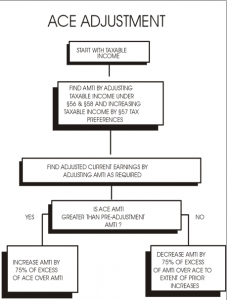paystubmakr.com present the last article about Unincorporated Associations.
ACE Adjustment (Post-1989)
At the tax years beginning after 12/31/89, the business untaxed reported profits adjustment is replaced with an adjusted current earnings (ACE) adjustment. The ACE is tax based and can be a negative amount. AMTI is higher by 75% of the excess of ACE over unadjusted AMTI. Or AMTI is
The ace adjustment is tax based and can be a negative Bellow Quote
“Reduced by 75% of the excess of unadjusted AMTI over ACE. The negative adjustment is limited to the aggregate of the positive adjustments under ACE for prior years reduced by the previously claimed negative adjustments. Thus, the ordering of the timing differences is crucial because any lost negative adjustment is perpetual. Unadjusted AMTI is AMTI without the ACE adjustment of the AMT NOL (§56(g)(1) & (2)).”

ACE should not be confused with current earnings and profits. Although many items are treated the same, certain items that are deductible in computing earnings and profits (but are not deductible in calculating taxable income) generally are not deductible in computing ACE (e.g., Federal income taxes).
A guide to the corporate alternative minimum tax (AMT)
The first step for computing ACE is AMTI, which is defined as regular taxable income after AMT adjustments (other than the NOL and ACE adjustments) and tax preferences (§56(g)(3)). The resulting figure is then adjusted for the following items to determine ACE:
1. Depreciation: Effective for property placed in service after December 31, 1993, the depreciation component of the adjustment used in computing ACE is eliminated.

2. Exclusion Items: These are earning items (net of related expenses) that are included in earnings and profits, but will never be included in the regular taxable income of AMTI (except on liquidation or disposal of a business). An example would be interest income from tax-exempt bonds. Exclusion expense items do not include fines and penalties, disallowed golden parachute payments, and the disallowed portion of meals and entertainment expenses.
International Estate & Tax Planning 2019
3. Banned Items: A tax deduction is not allowed in computing ACE if it is never deductible in computing earnings and profits. Thus, the dividends received the deduction, and net operating loss deduction is not allowed. However, since the starting point for ACE is AMTI before the NOL, no Adjustment is necessary for NOL. An exception does allow the 100% dividends received the deduction if the payor corporation and recipient business are not members of the same group and an 80% deduction. When a recipient corporation has at least 20% ownership of the payor corporation (§56(g)(4)(C)(i) & (ii)). The exception does not cover dividends received from corporations where the ownership percentage is less than 20%.

4. Miscellaneous Adjustments: The following adjustments, which are required for regular earnings and profits purposes, are necessary:
(a) Intangible drilling costs,
(b) Construction period carrying charges,
(c) Circulation expenditures,
(d) Mineral exploration and development cost,
(e) Organization expenditures,
(f) LIFO inventory adjustments,
(g) Installment sales, and
(i) Long-term contracts (§312(n)(1) through (6)).
Other special rules apply to disallowed losses on the exchange of debt pools, acquisition expenses of life insurance companies, depletion, and certain ownership changes.
Small Businesses AMT Exclusion
Tax law imposes a minimum tax on an individual or a corporation to the extent the taxpayer’s minimum tax liability exceeds its regular tax liability. The personal minimum tax is imposed at rates of 26% and 28% on alternative minimum taxable income more than a phase-out exemption amount; the corporate minimum tax is imposed at a rate of 20% on alternative minimum taxable income more than a phased-out $40,000 exemption amount. Alternative minimum taxable income (‘‘AMTI’’)

Quoted from “The ace adjustment is tax based and can be a negative.”
“Is the taxpayer’s taxable income increased by certain preference items and adjusted by determining the tax treatment of certain items in a manner that negates the deferral of income resulting from the regular tax treatment of those items.”
In the case of a corporation, in addition to the regular set of adjustments and preferences, there is a second set of adjustments known as the
‘‘adjusted current earnings’’ adjustment. However, for taxable years beginning after 1997, the TRA ‘97 repealed the corporate alternative minimum tax for “small business corporations.”
Small Business Corporation
A corporation is a small business corporation for its first taxable years beginning after 1997 when it has average gross receipts of no greater than $5 million for three consecutive taxable years beginning with the taxable year beginning after Dec. 31, 1994. A corporation that meets the $5 million test continues as a small business corporation its average gross receipts do not exceed $7.5 million.

A corporation that subsequently earns more than $7.5 million of gross receipts becomes subject to the corporate alternative minimum tax, but only for adjustments and references on transactions and investments entered into after the corporation loses its status as a small business corporation.
Transition Rule
Small businesses that had alternative minimum tax credit carryforwards on August 5, 1997, may utilize their credit to reduce their regular tax liability to no less than 25% of the amount by which their regular liability exceeds $25,000.
